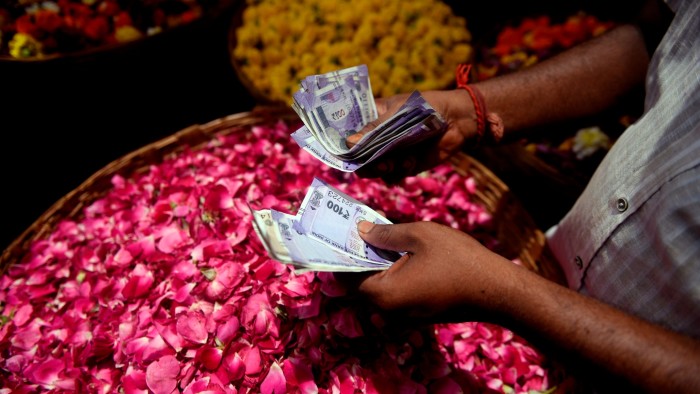Unlock the Editor’s Digest for free
Roula Khalaf, Editor of the FT, selects her favourite stories in this weekly newsletter.
A drop in the value of India’s rupee has shaken expectations that the new head of the central bank will quickly cut interest rates to stimulate the country’s flagging economy.
The currency has repeatedly hit lows and a 0.7 per cent fall against the dollar on Monday was its biggest one-day dip in nearly two years.
That decline and its implications for inflation have shattered the previously near-uniform consensus among economists that Reserve Bank of India governor Sanjay Malhotra and fellow monetary policy setters will next month cut the benchmark repo rate from 6.5 per cent, the level it has been held at for nearly two years.
The falling rupee is only one of a number of indicators taking the shine off of what remains the world’s fastest-growing major economy.
India registered a sharp drop in year-on-year GDP growth to 5.4 per cent in the quarter through to the end of September, the lowest level in nearly two years, amid a slowdown in government spending, waning consumption and weak corporate earnings.
“The rupee fall is serious for the new RBI governor,” said Madan Sabnavis, chief economist at Bank of Baroda, adding that it had “muddied the view” that there would be a headline rate cut at Malhotra’s first policy meeting, which opens just a few days after the central government lays out its annual budget on February 1.
“A freefall has implications for imported inflation and hence monetary policy, which is the conundrum,” Sabnavis said.
India relies on overseas suppliers for almost 90 per cent of its oil consumption, making it particularly vulnerable to a rise in crude prices that followed new US sanctions on Russian producers. Robust recent US economic data has also cast doubt on the need for the Federal Reserve to lower rates, helping strengthen the dollar.
Stubbornly persistent inflation, which has eroded the spending power of hundreds of millions of poor and middle-class Indian households, lies at the heart of the RBI’s dilemma.
Fuelled by soaring vegetable prices, headline inflation breached the upper 6 per cent limit of the central bank’s target band in October, though prices have since cooled with the rate slowing to 5.2 per cent in December.
Malhotra, who took office last month, had said he expected India’s economy to recover in 2025. He indicated the RBI would prioritise supporting “a higher growth path” after his predecessor Shaktikanta Das was criticised by the government for keeping borrowing costs elevated.
“It’s not an easy environment for the new governor,” said Trinh Nguyen, emerging Asia economist at Natixis, adding that “India is not alone in this conundrum” with most developing nations suffering from the strong dollar. “But fundamentally, I think growth will prevail as a priority even if a rapidly weakening rupee is a concern.”
The RBI has regularly intervened to prop up the currency, burning through almost $70bn of its foreign exchange reserves since they reached a record high of $705bn in September.
Some economists speculate that the more recent lack of strong RBI action to stem the rupee’s fall may mark a shift in stance under Malhotra towards a more market-driven view of the currency that could boost exports. The RBI did not respond to a request for comment.
Other experts are more sanguine about the impact of the rupee’s decline and believe the RBI has plenty of room to manoeuvre given an overall trend of declining inflation and the central bank’s still considerable reserves.
“I don’t think it’s as big a deal as it’s being made out to be,” said Miguel Chanco, chief emerging Asia economist at research consultancy Pantheon Macroeconomics. The rupee’s more than 4 per cent depreciation against the dollar over the past year remained “fairly manageable”, Chanco said.
“It’s worth remembering that it’s probably been due a downshift for some time, having looked pricey on a real effective exchange rate basis over the past 18 months or so,” he said.
More broadly, while the RBI and India’s government last month slashed their growth forecasts for the coming year to their lowest since the Covid-19 pandemic, the central bank said the economy was showing signs of bottoming out.
Chanco said that view might be too optimistic, given that India’s fiscal and monetary policy remained tight, households were weighed down with debt and industrial capacity utilisation still was not at levels high enough to spark a fresh cycle of investment.
“We probably have at least one more big downshift in headline GDP growth,” he said.
However, another economist said the rebound in government capital expenditure that had been put on hold during last year’s general election could also bode well for a revival of the Indian economy in the months to come.
“Structurally the economy is resilient,” said Poonam Gupta, director-general of the National Council of Applied Economic Research in New Delhi. “It’s a cyclical slowdown which timely policy actions can easily reverse.”
Read the full article here

